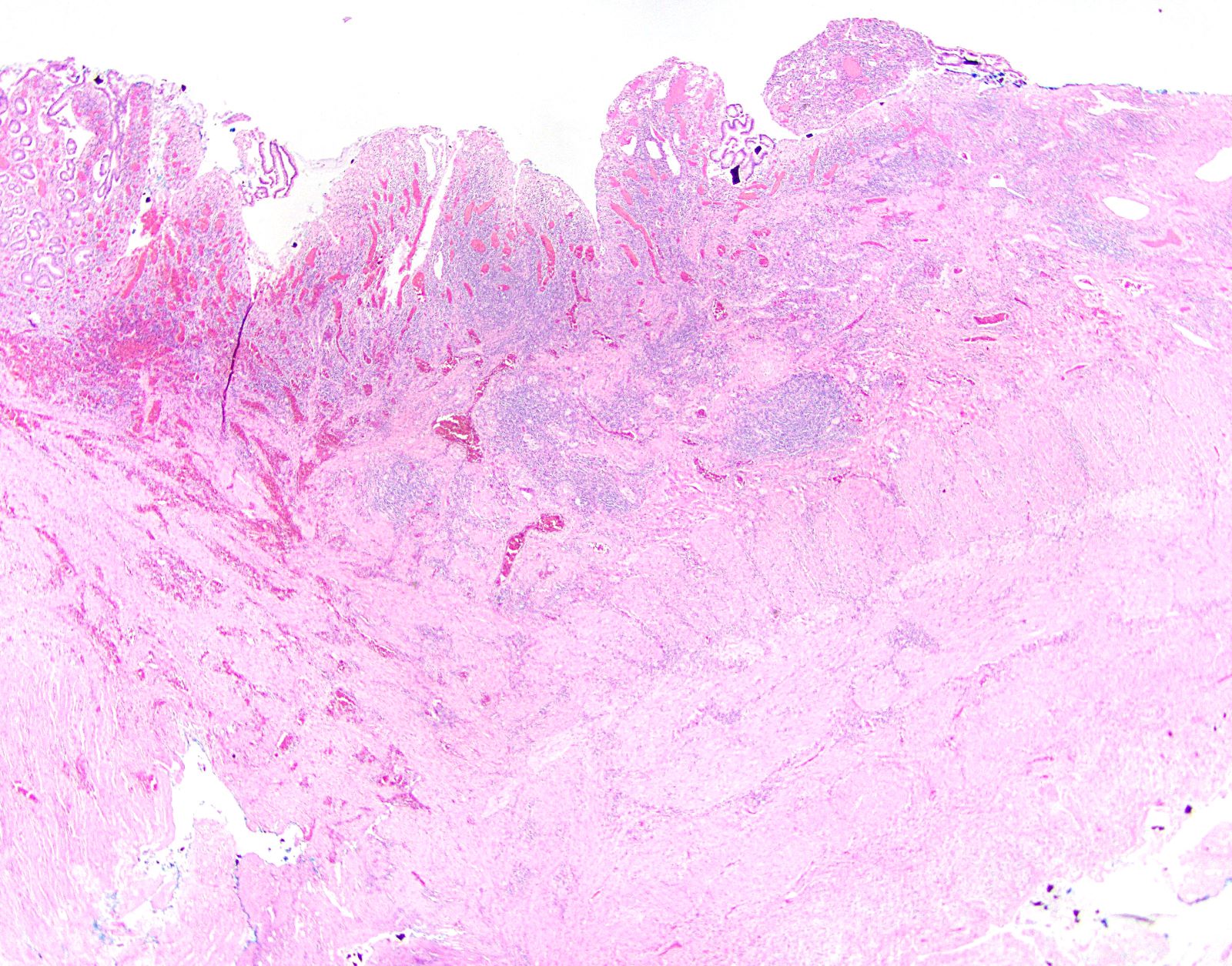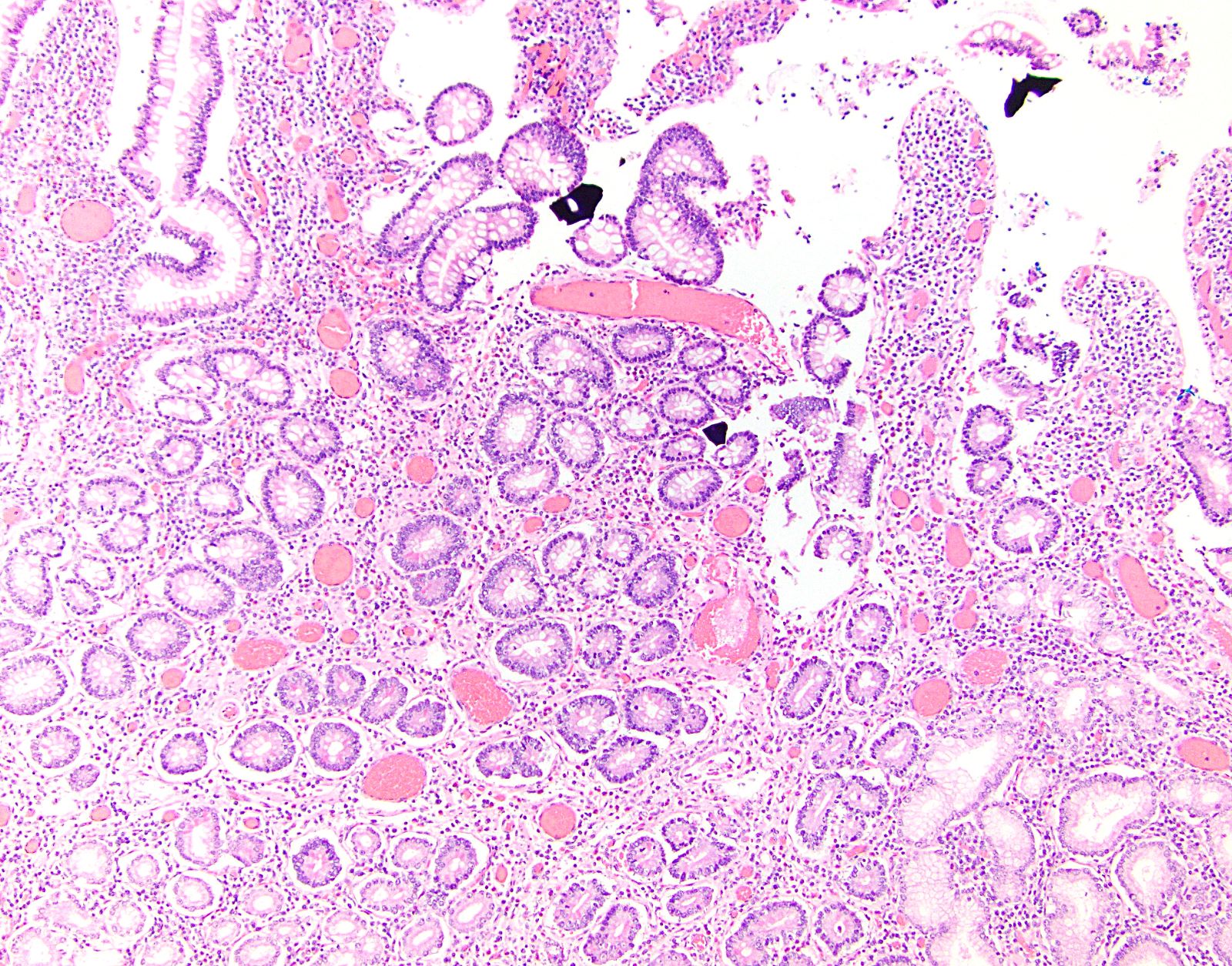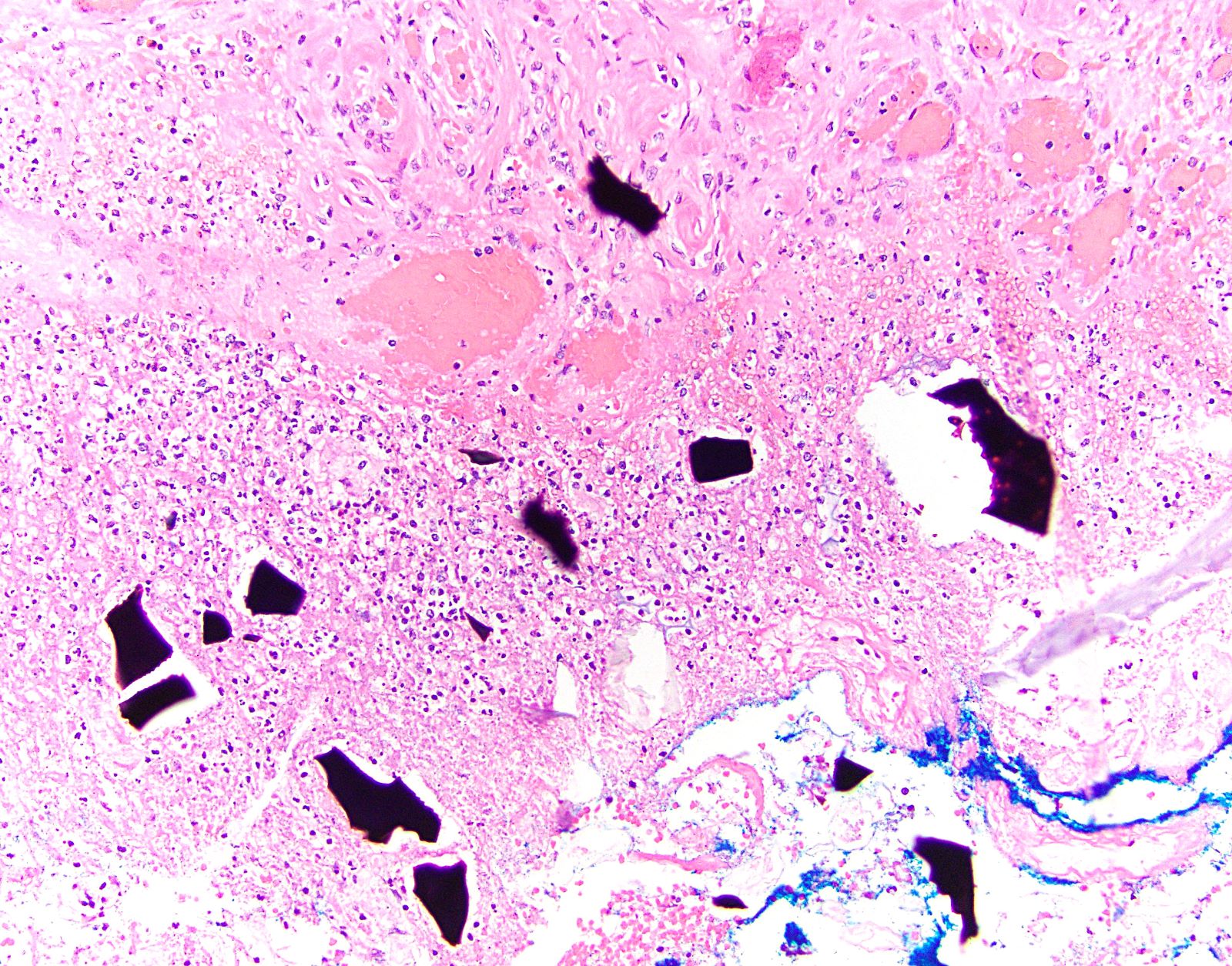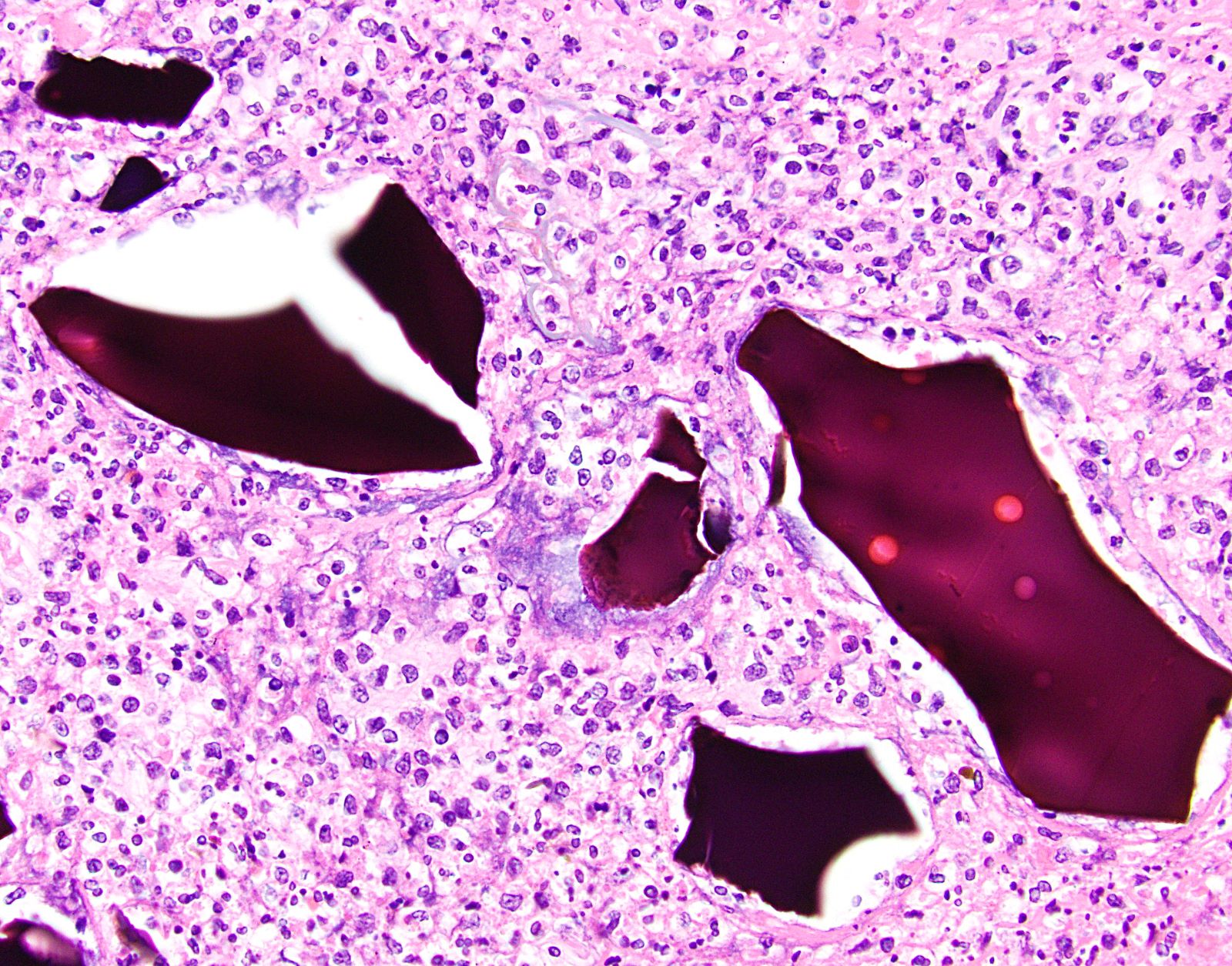17 June 2020 - Case of the Month #492
All cases are archived on our website. To view them sorted by case number, diagnosis or category, visit our main Case of the Month page. To subscribe or unsubscribe to Case of the Month or our other email lists, click here.
Thanks to Dr. Raul Gonzalez, Beth Israel Deaconess Medical Center, Boston, Massachusetts (USA), for contributing this case and writing the discussion.

Advertisement Register for the webcast here
Case of the Month #492
Clinical history:
A 68 year old woman with a history of Crohn's disease presented with small bowel perforation.
Histopathology images:
What is your diagnosis?
Diagnosis: Bile acid resin crystals
Test question (answer at the end):
Which of the following pill material fragments usually shows fish scales on histology?
A. Colestipol
B. Crospovidone
C. Microcrystalline cellulose
D. Sevelamer
Discussion:
A variety of medications and related materials can be identified microscopically, usually in gastrointestinal tract specimens (Arch Pathol Lab Med 2017;141:1276). Among these are bile acid sequestrant resin crystals from colestipol, colesevelam or cholestyramine (Am J Surg Pathol 2014;38:1530). These bind components of bile in the gastrointestinal tract, preventing them from being reabsorbed and then exacerbating diarrhea from bile acid malabsorption. Histologically, they appear as jagged, angulated fragments of orange to black crystals (depending on histology laboratory conditions), occasionally with small pink “bubbles,” as seen in this case. They typically do not show a fish scale pattern and instead have a glassy texture. Bile acid sequestrants do not cause tissue damage; the perforation in this case was due to the patient’s Crohn’s disease and the resins were secondarily present.
The most classic and thoroughly studied medication encountered in the gastrointestinal tract is Kayexalate (sodium polystyrene sulfonate) (Am J Surg Pathol 2001;25:637), which is used to bind excess potassium in renal failure patients. It also appears as jagged medication fragments, though the crystals are purple with a fish scale texture. Kayexalate has been widely reported to cause tissue damage, including bowel perforation, though this may be due at least in part to its sorbitol diluent (PLoS One 2015;10:e0137636).
Sevelamer is also used in renal failure patients to lower phosphate levels. Its microscopic crystals also demonstrate fish scales, though the coloration is typically pink in the center and yellow along the periphery. It has also been implicated in causing direct mucosal injury (Am J Surg Pathol 2013;37:1686).
Crospovidone and microcrystalline cellulose are inert materials used in pills, the former to facilitate drug absorption and the latter as a bulking agent (Am J Surg Pathol 2017;41:564). Neither can cause mucosal injury. Crospovidone appears as shiny, pink-purple, convoluted coral shaped material, while microcrystalline cellulose is composed of small, choppy fragments of transparent polarizable material.
Test question answer:
D. Sevelamer
All cases are archived on our website. To view them sorted by case number, diagnosis or category, visit our main Case of the Month page. To subscribe or unsubscribe to Case of the Month or our other email lists, click here.
Thanks to Dr. Raul Gonzalez, Beth Israel Deaconess Medical Center, Boston, Massachusetts (USA), for contributing this case and writing the discussion.

Advertisement Register for the webcast here
Case of the Month #492
Clinical history:
A 68 year old woman with a history of Crohn's disease presented with small bowel perforation.
Histopathology images:
What is your diagnosis?
Click here for diagnosis, test question and discussion:
Diagnosis: Bile acid resin crystals
Test question (answer at the end):
Which of the following pill material fragments usually shows fish scales on histology?
A. Colestipol
B. Crospovidone
C. Microcrystalline cellulose
D. Sevelamer
Discussion:
A variety of medications and related materials can be identified microscopically, usually in gastrointestinal tract specimens (Arch Pathol Lab Med 2017;141:1276). Among these are bile acid sequestrant resin crystals from colestipol, colesevelam or cholestyramine (Am J Surg Pathol 2014;38:1530). These bind components of bile in the gastrointestinal tract, preventing them from being reabsorbed and then exacerbating diarrhea from bile acid malabsorption. Histologically, they appear as jagged, angulated fragments of orange to black crystals (depending on histology laboratory conditions), occasionally with small pink “bubbles,” as seen in this case. They typically do not show a fish scale pattern and instead have a glassy texture. Bile acid sequestrants do not cause tissue damage; the perforation in this case was due to the patient’s Crohn’s disease and the resins were secondarily present.
The most classic and thoroughly studied medication encountered in the gastrointestinal tract is Kayexalate (sodium polystyrene sulfonate) (Am J Surg Pathol 2001;25:637), which is used to bind excess potassium in renal failure patients. It also appears as jagged medication fragments, though the crystals are purple with a fish scale texture. Kayexalate has been widely reported to cause tissue damage, including bowel perforation, though this may be due at least in part to its sorbitol diluent (PLoS One 2015;10:e0137636).
Sevelamer is also used in renal failure patients to lower phosphate levels. Its microscopic crystals also demonstrate fish scales, though the coloration is typically pink in the center and yellow along the periphery. It has also been implicated in causing direct mucosal injury (Am J Surg Pathol 2013;37:1686).
Crospovidone and microcrystalline cellulose are inert materials used in pills, the former to facilitate drug absorption and the latter as a bulking agent (Am J Surg Pathol 2017;41:564). Neither can cause mucosal injury. Crospovidone appears as shiny, pink-purple, convoluted coral shaped material, while microcrystalline cellulose is composed of small, choppy fragments of transparent polarizable material.
Test question answer:
D. Sevelamer





